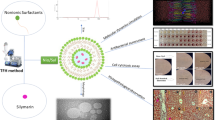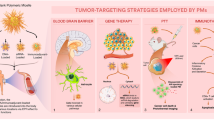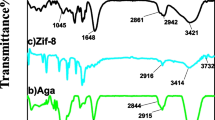Abstract
The combination of natural and synthetic polymeric materials grafted hydrogels offer great potential as oral therapeutic systems because of its intrinsic biocompatibility, biodegradability, protect labile drugs from metabolism and controlled release properties. Hence, in the present study, we aimed to prepare and optimize oral delivered pH-responsive Zein-co-acrylic acid hydrogels incorporated with 5-fluorouracil (5-Fu) and rutin (Ru) for effective anticancer activity with less toxicity. In this study, graft polymerization technique is adopted to formulate hydrogels with various ratios of Zein, acrylic acid, N, N-methylene bisacrylamide, and ammonium persulphate as an initiator. The optimized formulation was identified based on the cross-linking, chemical interactions, intrinsic viscosity (η), dynamic swelling (Q) at pH 1.2, diffusion coefficient (D), sol–gel fraction (%), and porosity (%). The selected optimized formulation has shown significant improvement in drugs loading and encapsulation efficiency, releasing at pH 1.2 and pH 7.4. Drug release kinetics studies confirmed the controlled release properties of hydrogels. Hydrogels were porous and the drug loading of 5-Fu and Ru was found to be 12.13% and 10.86%, respectively, whereas encapsulation efficiency of 5-Fu and Ru was 89.35% and 81.47%, respectively. Furthermore, form the in vitro cytotoxic screening, it was found that 52.5 µg mL−1 5-Fu and Ru-loaded hydrogel impacted 50% of cell death at 24 h, there by significantly arresting the proliferation of MDA-MB-231 and MCF-7 breast cancer cell lines. Altogether, the optimized pH-responsive hydrogels make them favorable carrier for anticancer drugs for oral delivery.













Similar content being viewed by others
References
Ahmed EM (2015) Hydrogel: preparation, characterization, and applications: a review. J Adv Res 6(2):105–121
Alberts B, Johnson A, Lewis J, Raff M, Roberts K, Walter P (2002) Cancer treatment: present and future. In: Molecular biology of the cell, 4th edn. Oxford University Press, Garland Science, New York
Alla SGA, El-Din HMN, El-Naggar AWM (2007) Structure and swelling-release behaviour of poly (vinyl pyrrolidone) (PVP) and acrylic acid (AAc) copolymer hydrogels prepared by gamma irradiation. Eur Polymer J 43(7):2987–2998
Arıca B, Çalış S, Kaş H, Sargon M, Hıncal A (2002) 5-Fluorouracil encapsulated alginate beads for the treatment of breast cancer. Int J Pharm 242(1–2):267–269
Aydin R, Pulat M (2012) 5-Fluorouracil encapsulated chitosan nanoparticles for pH-stimulated drug delivery: evaluation of controlled release kinetics. J Nanomater 2012:1–10
Barrera G (2012) Oxidative stress and lipid peroxidation products in cancer progression and therapy. ISRN Oncol 2012:1–22
Barrett EP, Joyner LG, Halenda PP (1951) The determination of pore volume and area distributions in porous substances. I. Computations from nitrogen isotherms. J Am Chem Soc 73(1):373–380
Bashir S, Teo YY, Naeem S, Ramesh S, Ramesh K (2017) pH responsive N-succinyl chitosan/poly (acrylamide-co-acrylic acid) hydrogels and in vitro release of 5-fluorouracil. PLoS One 12(7):e0179250
Bastiancich C, Bozzato E, Luyten U, Danhier F, Bastiat G, Préat V (2019) Drug combination using an injectable nanomedicine hydrogel for glioblastoma treatment. Int J Pharm 548(1):522–529
Bettini R, Colombo P, Massimo G, Catellani PL, Vitali T (1994) Swelling and drug release in hydrogel matrices: polymer viscosity and matrix porosity effects. Eur J Pharm Sci 2(3):213–219
Biswas GR, Majee SB, Roy A (2016) Combination of synthetic and natural polymers in hydrogel: an impact on drug permeation. J Appl Pharm Sci 6(11):158–164
Brazel CS, Peppas NA (1995) Synthesis and Characterization of thermo-and chemomechanically responsive poly (N-isopropylacrylamide-co-methacrylic acid) hydrogels. Macromolecules 28(24):8016–8020
Calabro M, Tommasini S, Donato P, Stancanelli R, Raneri D, Catania S, Costa C, Villari V, Ficarra P, Ficarra R (2005) The rutin/β-cyclodextrin interactions in fully aqueous solution: spectroscopic studies and biological assays. J Pharm Biomed Anal 36(5):1019–1027
Caló E, Khutoryanskiy VV (2015) Biomedical applications of hydrogels: a review of patents and commercial products. Eur Polymer J 65:252–267
Campbell KT, Stilhano RS, Silva EA (2018) Enzymatically degradable alginate hydrogel systems to deliver endothelial progenitor cells for potential revasculature applications. Biomaterials 179:109–121
Cao J, Han J, Xiao H, Qiao J, Han M (2016) Effect of tea polyphenol compounds on anticancer drugs in terms of anti-tumor activity, toxicology, and pharmacokinetics. Nutrients 8(12):762
Carmeliet P, Jain RK (2000) Angiogenesis in cancer and other diseases. Nature 407(6801):249
Da Costa CAM, Moraes ÂM (2003) Encapsulation of 5-fluorouracil in liposomes for topical administration. Maringá 25(1):53–61
Dai X, Tan C (2015) Combination of microRNA therapeutics with small-molecule anticancer drugs: mechanism of action and co-delivery nanocarriers. Adv Drug Deliv Rev 81:184–197
Damaraju VL, Damaraju S, Young JD, Baldwin SA, Mackey J, Sawyer MB, Cass CE (2003) Nucleoside anticancer drugs: the role of nucleoside transporters in resistance to cancer chemotherapy. Oncogene 22(47):7524
Danhier F, Feron O, Préat V (2010) To exploit the tumor microenvironment: passive and active tumor targeting of nanocarriers for anti-cancer drug delivery. J Control Release 148(2):135–146
Djeridane A, Yousfi M, Nadjemi B, Boutassouna D, Stocker P, Vidal N (2006) Antioxidant activity of some Algerian medicinal plants extracts containing phenolic compounds. Food Chem 97(4):654–660
Eng C (2009) Toxic effects and their management: daily clinical challenges in the treatment of colorectal cancer. Nat Rev Clin Oncol 6(4):207–218
Ferlay J, Shin HR, Bray F, Forman D, Mathers C, Parkin DM (2010) Estimates of worldwide burden of cancer in 2008: GLOBOCAN 2008. Int J Cancer 127(12):2893–2917
Florea A-M, Büsselberg D (2011) Cisplatin as an anti-tumor drug: cellular mechanisms of activity, drug resistance and induced side effects. Cancers 3(1):1351–1371
Gil ES, Hudson SM (2004) Stimuli-reponsive polymers and their bioconjugates. Prog Polym Sci 29(12):1173–1222
Gupta P, Vermani K, Garg S (2002) Hydrogels: from controlled release to pH-responsive drug delivery. Drug Discov Today 7(10):569–579
Hennink WE, van Nostrum CF (2012) Novel crosslinking methods to design hydrogels. Adv Drug Deliv Rev 64:223–236
Hickey T, Kreutzer D, Burgess D, Moussy F (2002) Dexamethasone/PLGA microspheres for continuous delivery of an anti-inflammatory drug for implantable medical devices. Biomaterials 23(7):1649–1656
Himri I, Guaadaoui A (2018) Cell and organ drug targeting: types of drug delivery systems and advanced targeting strategies. In: Nanostructures for the engineering of cells, tissues and organs. William Andrew, Elsevier, Oxford, pp 1–66
Hoffman A (1998) Pharmacodynamic aspects of sustained release preparations. Adv Drug Deliv Rev 33(3):185–199
Johnstone RW, Ruefli AA, Lowe SW (2002) Apoptosis: a link between cancer genetics and chemotherapy. Cell 108(2):153–164
Kanamala M, Wilson WR, Yang M, Palmer BD, Wu Z (2016) Mechanisms and biomaterials in pH-responsive tumour targeted drug delivery: a review. Biomaterials 85:152–167
Kevadiya BD, Joshi GV, Mody HM, Bajaj HC (2011) Biopolymer–clay hydrogel composites as drug carrier: host–guest intercalation and in vitro release study of lidocaine hydrochloride. Appl Clay Sci 52(4):364–367
Kumari A, Yadav SK, Yadav SC (2010) Biodegradable polymeric nanoparticles based drug delivery systems. Colloids Surf B 75(1):1–18
Kunjiappan S, Panneerselvam T, Somasundaram B, Sankaranarayanan M, Chowdhury R, Chowdhury A, Bhattacharjee C (2018) Design, in silico modeling, biodistribution study of rutin and quercetin loaded stable human hair keratin nanoparticles intended for anticancer drug delivery. Biomed Phys Eng Express 4(2):025019
Kwon Y (2014) Effect of soy isoflavones on the growth of human breast tumors: findings from preclinical studies. Food Sci Nutr 2(6):613–622
Labib G (2018) Overview on Zein Protein: a promising pharmaceutical excipient in drug delivery systems and tissue engineering. Expert Opin Drug Deliv 15(1):65–75
Langer R, Peppas NA (1981) Present and future applications of biomaterials in controlled drug delivery systems. Biomaterials 2(4):201–214
Lee JH, Bucknall DG (2008) Swelling behavior and network structure of hydrogels synthesized using controlled UV-initiated free radical polymerization. J Polym Sci Part B Polym Phys 46(14):1450–1462
Leslie A (1954) Ethics and practice of placebo therapy. The American Journal of Medicine 16(6):854–862
Lin C-C, Metters AT (2006) Hydrogels in controlled release formulations: network design and mathematical modeling. Adv Drug Deliv Rev 58(12–13):1379–1408
Lordi NG (1986) Sustained release dosage forms. Theory Pract Ind Pharm 3:430–456
Lutolf M, Hubbell J (2003) Synthesis and physicochemical characterization of end-linked poly (ethylene glycol)-co-peptide hydrogels formed by Michael-type addition. Biomacromol 4(3):713–722
Malafaya PB, Silva GA, Reis RL (2007) Natural–origin polymers as carriers and scaffolds for biomolecules and cell delivery in tissue engineering applications. Adv Drug Deliv Rev 59(4–5):207–233
Memic A, Alhadrami HA, Hussain MA, Aldhahri M, Al Nowaiser F, Al-Hazmi F, Oklu R, Khademhosseini A (2015) Hydrogels 2.0: improved properties with nanomaterial composites for biomedical applications. Biomed Mater 11(1):014104
Nair LS, Laurencin CT (2007) Biodegradable polymers as biomaterials. Prog Polym Sci 32(8–9):762–798
Nayak AK, Malakar J, Sen KK (2010) Gastroretentive drug delivery technologies: current approaches and future potential. J Pharm Educ Res 1(2):1–12
Ninan N, Forget A, Shastri VP, Voelcker NH, Blencowe A (2016) Antibacterial and antiinflammatory pH-responsive tannic acid-carboxylated agarose composite hydrogels for wound healing. ACS Appl Mater Interfaces 8(42):28511–28521
Omer A, Tamer T, Hassan M, Rychter P, Eldin MM, Koseva N (2016) Development of amphoteric alginate/aminated chitosan coated microbeads for oral protein delivery. Int J Biol Macromol 92:362–370
Peppas N, Bures P, Leobandung W, Ichikawa H (2000) Hydrogels in pharmaceutical formulations. Eur J Pharm Biopharm 50(1):27–46
Peters GJ, Ackland SP (1996) Leading article: oncologic, endocrine and metabolic: new antimetabolites in preclinical and clinical development. Expert Opin Investig Drugs 5(6):637–679
Petrak K (1990) Polymers for use in drug delivery—property and structure requirements. Br Polym J 22(3):213–219
Ps S, Joshi VG (2013) Preparation and characterisation of 5-fluorouracil loaded PLGA nanoparticles for colorectal cancer therapy. Unique J Pharm Biol Sci 01(02):52–58
Rama AR, Hernandez R, Perazzoli G, Burgos M, Melguizo C, Vélez C, Prados J (2015) Specific colon cancer cell cytotoxicity induced by bacteriophage E gene expression under transcriptional control of carcinoembryonic antigen promoter. Int J Mol Sci 16(6):12601–12615
Ramalingam V, Varunkumar K, Ravikumar V, Rajaram R (2016) Development of glycolipid biosurfactant for inducing apoptosis in HeLa cells. RSC Adv 6(68):64087–64096
Ranjha NM, Qureshi UF (2014) Preparation and characterization of crosslinked acrylic acid/hydroxypropyl methyl cellulose hydrogels for drug delivery. Int J Pharm Pharm Sci 6(4):400–410
Ranjha NM, Ayub G, Naseem S, Ansari MT (2010) Preparation and characterization of hybrid pH-sensitive hydrogels of chitosan-co-acrylic acid for controlled release of verapamil. J Mater Sci Mater Med 21(10):2805–2816
Ryu J-H, Chacko RT, Jiwpanich S, Bickerton S, Babu RP, Thayumanavan S (2010) Self-cross-linked polymer nanogels: a versatile nanoscopic drug delivery platform. J Am Chem Soc 132(48):17227–17235
Sahoo S, Chung C, Khetan S, Burdick JA (2008) Hydrolytically degradable hyaluronic acid hydrogels with controlled temporal structures. Biomacromol 9(4):1088–1092
Sakamoto JH, van de Ven AL, Godin B, Blanco E, Serda RE, Grattoni A, Ziemys A, Bouamrani A, Hu T, Ranganathan SI (2010) Enabling individualized therapy through nanotechnology. Pharmacol Res 62(2):57–89
Schmaljohann D (2006) Thermo-and pH-responsive polymers in drug delivery. Adv Drug Deliv Rev 58(15):1655–1670
Selvaraj K, Chowdhury R, Bhattacharjee C (2013) Isolation and structural elucidation of flavonoids from aquatic fern Azolla microphylla and evaluation of free radical scavenging activity. Int J Pharm Pharm Sci 5(3):743–749
Selvaraj K, Chowdhury R, Bhattacharjee C (2014) Optimization of the solvent extraction of bioactive polyphenolic compounds from aquatic fern Azolla microphylla using response surface methodology. Int Food Res J 21(4):1559–1567
Sharpe LA, Daily AM, Horava SD, Peppas NA (2014) Therapeutic applications of hydrogels in oral drug delivery. Expert Opin Drug Deliv 11(6):901–915
Sheu M-T, Jhan H-J, Hsieh C-M, Wang C-J, Ho H-O (2015) Efficacy of antioxidants as a complementary and alternative medicine (CAM) in combination with the chemotherapeutic agent doxorubicin. Integr Cancer Ther 14(2):184–195
Siegel RL, Miller KD, Jemal A (2019) Cancer statistics, 2019. CA Cancer J Clin 69(1):7–34
Trachootham D, Alexandre J, Huang P (2009) Targeting cancer cells by ROS-mediated mechanisms: a radical therapeutic approach? Nat Rev Drug Discov 8(7):579–591
Üzüm ÖB, Karadağ E (2010) Equilibrium swelling studies of chemically cross-linked highly swollen acrylamide-sodium acrylate hydrogels in various water-solvent mixtures. Polym Plast Technol Eng 49(6):609–616
Varshosaz J, Hajian M (2004) Characterization of drug release and diffusion mechanism through hydroxyethylmethacrylate/methacrylic acid pH-sensitive hydrogel. Drug Deliv 11(1):53–58
Viloria-Petit A, Crombet T, Jothy S, Hicklin D, Bohlen P, Schlaeppi JM, Rak J, Kerbel RS (2001) Acquired resistance to the antitumor effect of epidermal growth factor receptor-blocking antibodies in vivo: a role for altered tumor angiogenesis. Can Res 61(13):5090–5101
Wong RSH, Dodou K (2017) Effect of drug loading method and drug physicochemical properties on the material and drug release properties of poly (ethylene oxide) hydrogels for transdermal delivery. Polymers 9(7):286–315
Wong RSH, Ashton M, Dodou K (2015) Effect of crosslinking agent concentration on the properties of unmedicated hydrogels. Pharmaceutics 7(3):305–319
Xu L, Qiu L, Sheng Y, Sun Y, Deng L, Li X, Bradley M, Zhang R (2018) Biodegradable pH-responsive hydrogels for controlled dual-drug release. J Mater Chem B 6(3):510–517
Yahia L, Chirani N, Gritsch L, Motta FL, Fare S (2015) History and applications of hydrogels. J Biomed Sci 4(2):1–13
Yin L, Fei L, Cui F, Tang C, Yin C (2007) Superporous hydrogels containing poly (acrylic acid-co-acrylamide)/O-carboxymethyl chitosan interpenetrating polymer networks. Biomaterials 28(6):1258–1266
Yu H, Xiao C (2008) Synthesis and properties of novel hydrogels from oxidized konjac glucomannan crosslinked gelatin for in vitro drug delivery. Carbohyd Polym 72(3):479–489
Zhang X-Z, Zhuo R-X, Cui J-Z, Zhang J-T (2002) A novel thermo-responsive drug delivery system with positive controlled release. Int J Pharm 235(1–2):43–50
Zohuriaan-Mehr MJ, Kabiri K (2008) Superabsorbent polymer materials: a review. Iran Polym J 17(6):451
Acknowledgements
The authors are grateful to Chancellor, Vice-President, and Vice-chancellor of Kalasalingam Academy of Research and Education (Deemed to be University), Krishnankoil, India, for research fellowships and utilizing research facilities. We thank Mr. P. Kathirvel, Mr. V. Krishnaprabhu Technicians for FTIR, SEM, XRD analysis, Sir CV Raman-KS Krishnan International Research Center, Kalasalingam Academy of Research and Education (Deemed to be University), Krishnankoil, India. We also thank Prof. Z. Maciej Gliwicz, Ms. Ewa Babkiwicz, and Dr. Piotr Maszczyk, Department of Hydrobiology, Faculty of Biology, University of Warsaw, Warszawa, Poland, for timely help and support.
Author information
Authors and Affiliations
Contributions
SK, PT, SB, and BS designed research; SK, SB, PP, GS, JN, and AW performed research; SM, SA, and BS contributed new reagents or analytical tools. All authors read and approved the final manuscript.
Corresponding author
Ethics declarations
Conflict of interest
The authors report no financial interest that might pose a potential, perceived, or real conflict of interest. The authors declare there are no competing interests.
Rights and permissions
About this article
Cite this article
Kunjiappan, S., Theivendran, P., Baskararaj, S. et al. Modeling a pH-sensitive Zein-co-acrylic acid hybrid hydrogels loaded 5-fluorouracil and rutin for enhanced anticancer efficacy by oral delivery. 3 Biotech 9, 185 (2019). https://doi.org/10.1007/s13205-019-1720-x
Received:
Accepted:
Published:
DOI: https://doi.org/10.1007/s13205-019-1720-x




